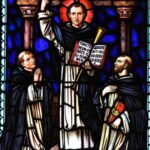St. Constantine
St. Constantine
An Emperor in the Making
Flavius Valerius Constantinus, known as St. Constantine the Great or St. Constantine I, was born probably around the late 280s. He was the son of Flavius Valerius Constantius, who was an army officer, and Helena. Constantine belonged to the military governing class of the later 3rd century. His father was raised to the rank of Caesar, or deputy emperor, in 293 and was sent to serve under Augustus Maximus in the West.
When his father died, Constantine was brought up in the Eastern Empire at the court of the senior emperor Diocletian at Nicomedia. As a member of the imperial court, Constantine’s experience there left a lasting imprint on him. As a Latin-speaking institution, the imperial court educated Constantine with less than the highest literary standards of his time. He became more at home in Latin than in Greek. Later in his life, he had the habit of delivering edifying sermons, which he composed in Latin and pronounced in Greek from professional translations.
Constantine and Christianity
Constantine encountered Christianity in court circles as well as in the cities. It was even possible that members of his family were Christians. However, from the year 303, during the great persecution of the Christians, which began at the court of Diocletian at Nicomedia, Christianity was a major issue of public policy and order. The persecution was enforced with specific intensity in the eastern parts of the empire. History tells us about the fate of many Christians during these years of persecution.
In 305, the two emperors Diocletian and Maximian stepped down. They were succeeded by their respective deputy emperors, Galerius and Constantius. The latter were replaced by Galerius Valerius Maximinus in the East and Flavius Valerius Severus in the West, with Constantine being passed over. Constantius requested his son’s presence from Galerius, and Constantine made his way through the territories of Severus and joined his father at Gesoriacum. Constantine was immediately acclaimed emperor by the army.
The Sole Emperor
Emperor Constantine threw himself into a complicated series of civil wars in which Maxentius, Maximian’s son, rebelled against Rome. Maxentius, with his father’s help, suppressed Severus. When Maximian was rejected by his son, he went to Gaul and joined Constantine, only to betray Constantine and be either murdered or forced to commit suicide around the year 310.
In 307, Constantine married Fausta, Maximian’s daughter, as his second wife. He invaded Italy in 312 and defeated his brother-in-law, Maxentius, at the Milvian Bridge near Rome. Not long after, he had other emperors, making Constantine the sole emperor of the East and West.
Throughout his life, Emperor Constantine ascribed his success to his conversion to Christianity and the support of the God of the Christians. His adherence to Christianity was closely associated with his rise to power. In the Battle of the Milvian Bridge, he fought in the name of the Christian God. He received instructions in a dream to paint the Christian monogram, the Chi-Rho, known as the sacred monogram, on the shields of his troops. It was formed by the conjunction of the first two Greek letters of the word Christ.”
Through the famous Edict of Milan in 312, Emperor Constantine made Christianity a free religion. He decreed that the persecutions be stopped and all the seized Christian properties be restored. He convened the Council of Nicea in 325, governed the distribution of land for the Church, established a new capital in the Christian city of Constantinople, and began policies that Christianized the empire. Emperor Constantine died around the year 337. His feast day is May 21.
5 Interesting Facts About St. Constantine
- St. Constantine is known as the first Christian emperor.
- St. Constantine was baptized as a Christian on his deathbed.
- A different version of St. Constantine’s vision says that during his campaign against Maxentius, a sign appeared in the sky: after midday, beneath the sun, a radiant pillar in the form of a cross with the words “By this shalt thou conquer.”
- St. Constantine is credited with finding the site of Golgotha and initiating the first building of the Church of the Holy Sepulcher. His mother, St. Helena, is credited with finding the true cross of Christ.
- St. Constantine is venerated as a saint by Eastern Orthodox Christians, Anglicans, and Byzantine Catholics.
Prayer to St. Constantine
O Lord, Your disciple Emperor Constantine, who saw in the sky the sign of Your Cross, accepted the call that came straight from You, as it happened to Paul, and not from any man. Preserve Your Church in everlasting peace through the intercession of the Mother of God, for You are the lover of mankind. Amen.



